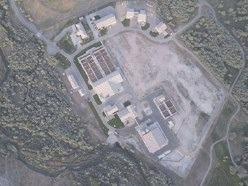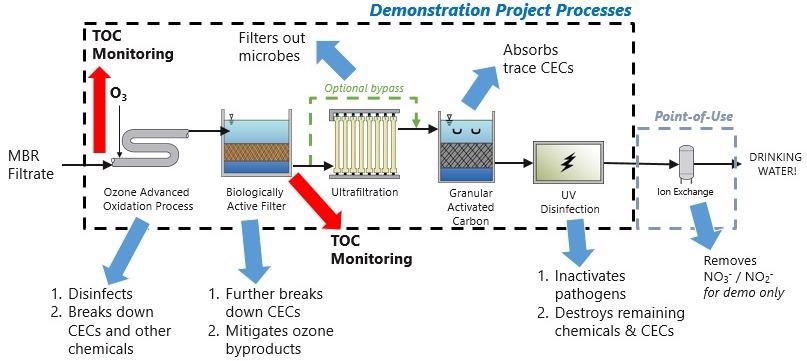Utah is one of the driest states in the United States, with 90% of its 54 million acres suffering from severe drought. Since groundwater has been polluted by mining wastes, the city of South Jordan in Salt Lake County, Utah, does not have local drinking water sources.
The city buys drinking water from a regional water source, with much of it coming from the Uintah Mountain range and the Provo River system.
As a result, a demonstration project was financed by the state of Utah to examine the viability of a Direct Potable Reuse (DPR) scheme. This demonstration plant will run for three to five years and serve as a model for potential DPR projects.

Figure 1. Aerial view of the demonstration DPR project. Image Credit: Veolia Water Technologies & Solutions
The DPR demonstration project will use treated wastewater from the South Valley Sewer as a source of supply. The DPR demonstration facility will use a variety of innovative procedures to accomplish not only water quality standards but also redundant and resilient treatment in a multiple barrier strategy to pollution treatment.
Ozonation, Biologically Active Filter (BAF), Ultrafiltration (UF), Granular Activated Carbon (GAC), and Ultraviolet (UV) disinfection are among the plant’s five process divisions.
Through the ozonation unit, incoming filtrate from the membrane bioreactor enters the sophisticated treatment process. Ozone is a strong oxidant that aids in the breakdown of organic pollutants.
The BAF is located downstream of the ozone oxidation process and provides media for bacteria to grow on and disintegrate pollutants. Microorganisms are filtered away by the UF, while trace pollutants are absorbed by the GAC.
UV disinfection, which is a particularly effective approach for disinfecting pathogens from water, is the final stage of the DPR demonstration.
Challenge
The public’s approval and opinion are crucial to the success of a DPR program. The public needs to be informed on the issue of water recycling and the science underpinning water purification, due to a widespread negative image of DPR initiatives. Furthermore, the demonstration DPR project’s prospects are strongly reliant on data-driven judgment.
As a result, project engineers are faced with the task of continuously measuring the configuration. The ability to have a simple but accurate measurement method is critical since the treatment process is intended to remove organic pollutants from source water and wastewater that damage public health and the environment.
The importance of understanding and quantifying organics from the first treatment and subsequent processes cannot be overstated.
Solution
Total Organic Carbon (TOC) was identified as a main Key Process Indicator (KPI) at the demonstration DPR plant in South Jordan, Utah. The factory needed an analyzer that could handle a variety of sample streams of carrying quality. Sievers M5310 C TOC Analyzers were chosen to suit these demands since they combine UV persulfate oxidation with Membrane Conductometric (MC) sensing.
The process structure and the purpose of each process unit are shown in Figure 2.

Figure 2. Breakdown of Direct Potable Reuse demonstration project processes. Image Credit: Whotcott and Rasmussen, 20191
The TOC is measured at the start of the DPR process. The effluent stream from the wastewater treatment plant to the DPR treatment plant is monitored continuously to fine-tune the advanced treatment techniques.
Furthermore, TOC is measured downstream of the Biologically Activated Filter to guarantee that pollutants are eliminated efficiently. TOC analysis can also be used to predict the overall quality following UV disinfection.
Conclusion
There are drinking water shortages in several parts of the United States. Innovational solutions like DPR projects are essential to building drought resiliency and supply independence in the future.
To change the public opinion of new drinking water sources like DPR, plants benefit from a rigorous water monitoring system where data can be used to make decisions and present reliable, precise information.
Organics monitoring using TOC analysis is a simple yet effective tool for improving processes, ensuring quality, and meeting compliance requirements. The City of South Jordan hopes to effectively demonstrate a DPR project and create doors for similar projects that will offer clean and cost-effective drinking water to local people using Sievers M5310 C Analyzers.
References
- Whotcott, G., & Rasmussen, J. (2019, July 29). South Jordan City – DPR Demonstration Project. Arizona Reuse Symposium. Symposium conducted at the meeting of Water Reuse Arizona & AZ Water Association, Flagstaff, AZ.

This information has been sourced, reviewed and adapted from materials provided by Veolia Water Technologies & Solutions
For more information on this source, please visit Veolia Water Technologies & Solutions